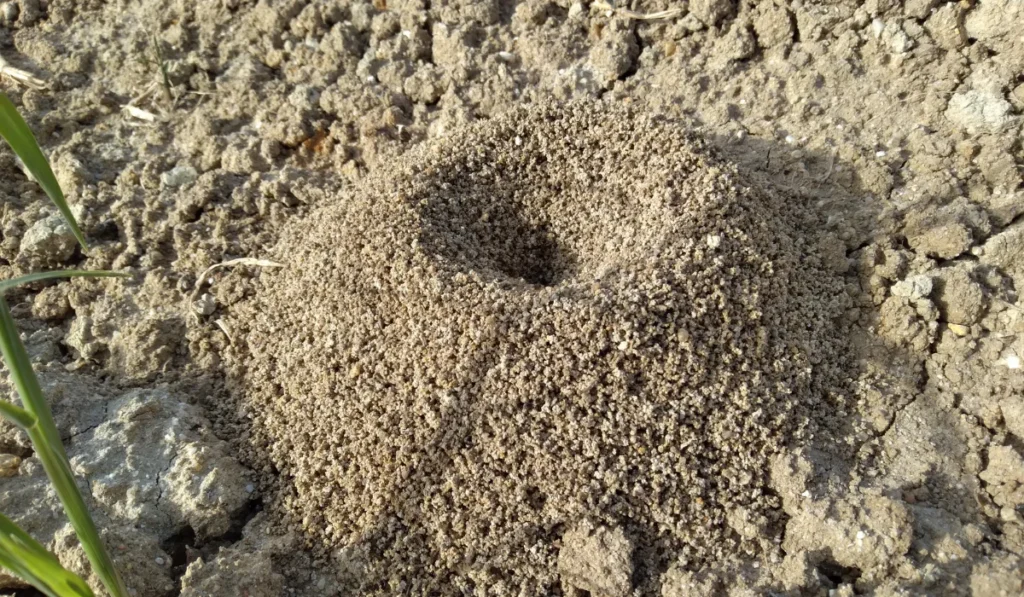
Fire ant mounds in Alabama lawns aren’t just unsightly. They’re a stubborn, painful nuisance that gets worse in summer. If you’ve lived in Birmingham or anywhere across the Southeast, you’ve likely stepped too close to one of these dirt domes and felt the wrath of their stings.
Fire ant activity peaks in August. The hot, dry August weather prompts fire ant colonies to expand their underground tunnels in search of cooler environments. This leads them to start building fresh mounds across yards and parks.
In this guide, we’ll walk through why these mounds appear, what makes August an ideal time for fire ant control, and how homeowners can safely treat them.
Key Takeaways
- August is a peak month for fire ant activity and the best time to treat mounds.
- Fire ant bait and individual mound treatments both help eliminate colonies.
- Red imported fire ants are aggressive and pose health risks through painful stings.
- Professional pest control is recommended for widespread or high-risk infestations.
What are fire ant mounds?
Fire ant mounds are the visible sign of a much larger issue hiding just below the surface. These dome-shaped structures sit above the extensive network of underground tunnels that make up a fire ant colony.
Red imported fire ants (Solenopsis invicta) don’t always follow predictable patterns like other ants, such as carpenter ants. Their mounds might show up in your lawn, garden beds, under pavement, or even next to electrical equipment. In Alabama, their fire ant mounds have become such a common sight that people practically consider them part of the landscape!
The red imported fire ant, native to South America, likely entered the United States through the Port of Mobile in the 1930s. Since then, they’ve spread rapidly across Alabama, Mississippi, Florida, Louisiana, Texas, and as far north as Tennessee.
Their aggressive behavior and painful stings can be dangerous for people with an allergic risk. Their ant venom can cause you to experience a stinging and burning sensation. In severe cases, their bite may cause you to have an allergic reaction or go into anaphylaxis shock.
Why August is ideal for treating fire ant mounds
Fire ants are most active by late summer. At this time, the colony’s worker ants are focused on two main tasks: searching for food sources and foraging to support the queen, and expanding the mound to accommodate new ants. You may notice large mounds popping up in freshly mowed areas or after rain.
Treating fire ant mounds in August offers two significant advantages:
- Maximum exposure: Foraging ants are most active during this time, so they’re more likely to pick up bait and take it back to the colony.
- Colony vulnerability: New colonies are forming, and existing ones are growing. If you treat now, you’ll knock back both.
Waiting until fall could mean missing your best shot to suppress fire ant populations before they go dormant in cooler months.
Fire ant mound treatment options
Fire ant management usually involves two primary methods that effectively handle ant infestations. Homeowners can opt for a broadcast bait treatment, which spreads bait across the yard. Meanwhile, others may choose individual mound treatments.
Fire ant bait (broadcast method)
Using granular fire ant bait is one of the most effective ways to reduce fire ant colonies across a lawn. These baits contain slow-acting ingredients that attract foraging ants. Once the worker ants carry the bait back to the fire ant nest, the entire colony, including the queen, is affected.
Popular brands like Amdro are explicitly designed for this task. The best time to use the bait is in the early morning or late afternoon, when worker ants are actively foraging.
For maximum effectiveness, make sure your yard is dry during application and for at least 24 hours after to ensure the bait remains effective.
Mound treatment (targeted method)
When dealing with individual mounds, huge ones near walkways or patios, a direct approach is necessary. This includes:
- Drenching the top of the mound with hot water. You don’t need to use boiling water. The water just has to be hot enough to eliminate the ants.
- Using a granular or liquid ant killer labeled for fire ant use.
- Avoiding disturbance before treatment. Stirring the mound may cause ants to relocate.
Many mound treatments rely on approved pesticide formulations. Always follow label directions or let a trained technician apply them safely.
If fire ants are near electrical equipment or structures, don’t attempt DIY treatment. Call a professional pest control company like Magic City Pest Control for safe and effective fire ant control.
Know your fire ant species
While red imported fire ants are the most notorious, Alabama is also home to other ant species, like the black imported fire ant. Both build similar mounds, form aggressive colonies, and deliver painful stings when threatened.
Their behavior makes early detection and proper treatment essential to prevent infestations from spreading. Alabama homeowners may also encounter other common ants, such as Argentine ants and carpenter ants, which require different control strategies.
Why quick action matters
Fire ant stings aren’t just painful. They can lead to serious medical issues. Fire ant venom can cause swelling, itching, and in severe cases, anaphylactic shock. Children and pets are especially vulnerable when playing near fire ant mounds.
If you’ve had an allergic reaction in the past or suspect fire ants are active around your home, don’t wait for it to get worse.
Tips to prevent new colonies
- Keep your lawn trimmed through regular mowing and avoid overwatering.
- Remove rotting wood and debris that can become nesting sites.
- Seal cracks in foundations and driveways where ants might migrate.
- Don’t leave food or pet bowls outside for long periods.
- Schedule regular pest control services, especially if you’re already dealing with other pests like termites.
Common mistakes to avoid
- Don’t treat mounds in the heat of the day. Ants retreat deep into their tunnels when it’s hot. Treatments and baits may not reach them.
- Avoid pouring bait directly on the mound. Fire ants won’t recognize it as food if the bait is poured directly on the mound.
- Skipping follow-up. Fire ants are persistent. A new colony may appear after initial treatment. We recommend re-treating in the fall if you still see activity.
If you’re in Birmingham or the surrounding areas and need help with a stubborn infestation, Magic City Pest Control offers fire ant management as part of our standard pest services.
Take back your yard from fire ants
Fire ant mounds in Alabama lawns aren’t just an August eyesore. They’re a real threat to your safety and comfort. By treating your fire ant infestation at the right time, using the right products, and staying consistent, you can reduce their presence before they go dormant in the fall. Whether you spot one mound or several, don’t wait to act.
Store-bought insecticides won’t help you get rid of your ant problem for good.
At Magic City Pest Control, we know Alabama lawns and have years of experience in effectively dealing with pest problems that plague Alabama homeowners year-round. We don’t offer a one-size-fits-all pest treatment.
Our team of trained technicians and exterminators develops custom treatment plans to address your home’s unique pest problem. Contact us today to get a free quote, so we can help you extinguish your fire ant problem for good.
FAQs
What do fire ant mounds look like?
Fire ant mounds are dome-shaped piles of loose soil with no visible entrance hole on top. They can range from a few inches to over a foot tall and often appear after rain or in sunny areas.
How dangerous are fire ant stings?
Fire ant stings are painful and can cause itchy welts. In some people, they trigger allergic reactions or even anaphylaxis. Children, pets, and those with known allergies are most at risk and should avoid infested areas.
Can I treat fire ant mounds myself?
Yes, you can treat mounds with fire ant bait or mound drenches. However, for large infestations or if mounds are near electrical equipment, it’s best to contact a professional.

